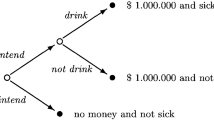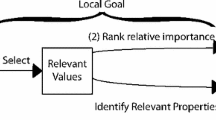Abstract
On the standard interpretation, if a person holds cyclical preferences, the person is prone to acting irrationally. I provide a different interpretation, tying cyclical preferences not to irrationality, but to indecision. According to this alternative understanding – coined the indecision interpretation – top cycles in a person’s preferences can be associated with a difficulty in justifying one’s choice. If an agent’s justificatory impasse persists despite attempts to resolve the cycle, the agent can be deemed undecided. The indecision interpretation is compatible with the standard interpretation of such cycles as instances of irrationality. Yet indecision corresponds to a first-person, non-instrumental perspective on the problem, whereas irrationality usually corresponds to a third-person, instrumental perspective. Due to these differences, interpreting cycles in terms of indecision offers a novel conceptual perspective, pertinent both for explanatory purposes and for the aim of normative theorizing.
Similar content being viewed by others
Notes
One may question whether instrumental rationality can reasonably be cashed out in terms of acyclical preference orderings (Thoma, manuscript). But such worries do not cast doubt on the fact that individuals are commonly viewed as rational because they evade contradictions in their preferences.
Of course, Sophie’s choice function is also defined over all other subsets of \(X\): the singleton sets, including each option separately, as well as the empty set.
Both situations can be grounds for indecision, since a full menu of undifferentiable alternatives may also pose a problem to the agent (to fully explain this point, see below for a distinction between an agent’s choice problem and her justification problem). Yet, importantly, the way in which these situations are associated with indecision differs as the agent’s relationship between her preferences and the applicable justificatory demand varies.
On this particular point, see Ullmann-Margalit and Morgenbesser (1977: 775).
To continue a previous comparison (noted in Table 1 above): whereas cycles can be a source of indecision only among sets of three or more options, uncertainty could apply to sets of just a single option (and so is unlike both incomparability or indifference which apply only to sets of two or more options).
In my depiction of a wanton, I am going a step further than Frankfurt did. Frankfurt (1971: 11) held that a wanton is capable of developing second-order desires:
“The fact that a wanton has no second-order volitions does not mean that each of his first-order desires is translated heedlessly and at once into action. He may have no opportunity to act in accordance with some of his desires. Moreover, the translation of his desires into action may be delayed or precluded either by conflicting desires of the first order or by the intervention of deliberation. For a wanton may possess and employ rational faculties of a high order. Nothing in the concept of a wanton implies that he cannot reason or that he cannot deliberate concerning how to do what he wants to do.”
Hence, on Frankfurt’s picture, the point is not that a wanton is incapable of deliberation, but that he cannot effectively control these desires through a high order decision which is wilful. Frankfurt (1971: 11) continues:
“What distinguishes the rational wanton from other rational agents is that he is not concerned with the desirability of his desires themselves. He ignores the question of what his will is to be.”
Importantly, a wanton thus is separated from a wilful agent (in his example, an unwilling addict) in the following way:
“The unwilling addict identifies himself, however, through the formation of a second-order volition, with one rather than with the other of his conflicting first-order desires.” (Frankfurt, 1971: 13).
Rather than drawing on language of wilful action and identification, I have simplified the concept of a wanton. The more extreme wanton I depict still has much in common with Frankfurt’s prototype, and suffices, as an example, to motivate basic contours of an account of reasoned control.
Interestingly, Ullmann-Margalit and Morgenbesser (1977: 780) are drawn to a seemingly opposite conclusion:
“Children, we say, see differences where we do not see any, or take trifling differences to be relevant – that is, to be sufficient reasons (usually patently ad hoc) for preference. Indeed we generally regard it as a sign of growing up when a child stops “behaving childishly” and is able to take a picking situation proper as just that (rather than fight with his or her little brother over who gets which).”
Even though their conclusion diverges from mine, there is a unified point here; namely, that grasping and resolving a justificatory impasse is a central component of developing one’s agential capacities.
References
Andreou, C. (2016). Cashing out the Money-Pump Argument. Philosophical Studies, 173.
Bradley, R. (2016). Decision theory with a Human Face. Cambridge University Press.
Broome, J. (1993). Can a Humean be moderate? In R. G. Frey, & C. W. Morris (Eds.), Ethics out of Economics. Cambridge University Press.
Chang, R. (1998). Introduction. In R. Chang (Ed.), Incommensurability, incomparability, and practical reason. Harvard University Press.
Frankfurt, H. G. (1971). Freedom of the Will and the Concept of a person. The Journal of Philosophy, 68.
Hampton, J. (1994). The Failure of Expected-Utility Theory as a Theory of Reason. Economics and Philosophy, 10.
Ullmann-Margalit, E., Morgenbesser, S. (1977). Picking and Choosing. Rationality, Choice, and Morality,44.
Sen, A. K. (1971). Choice Functions and Revealed Preference. The Review of Economic Studies, 38.
Sen, A. K. (1997). Maximization and the Act of Choice. Econometrica, 65.
Thoma, J. (2021). Preference Cycles and the Requirements of Instrumental Rationality.Working paper, available here: https://johannathoma.files.wordpress.com/2020/04/preference-cycles-april2020.pdf.
Acknowledgements
For discussion of related issues and comments on earlier versions of this article, I am grateful to Arthur Applbaum, Selim Berker, Tweedy Flanigan, Dimitrios Halikias, Christian List, Eric Maskin, Eric Nelson, Michael Rosen, Ken Shepsle and Richard Tuck. For written comments and suggestions, I am particularly indebted to Eric Beerbohm, Liya Nahusenay and Amartya Sen. I would also like to thank the journal’s two anonymous reviewers as well as audiences at Harvard University and LMU Munich for their helpful comments.
Author information
Authors and Affiliations
Corresponding author
Ethics declarations
Conflict of Interest
The author did not receive support from any organization for the submitted work.
Additional information
Publisher’s Note
Springer Nature remains neutral with regard to jurisdictional claims in published maps and institutional affiliations.
Rights and permissions
Springer Nature or its licensor (e.g. a society or other partner) holds exclusive rights to this article under a publishing agreement with the author(s) or other rightsholder(s); author self-archiving of the accepted manuscript version of this article is solely governed by the terms of such publishing agreement and applicable law.
About this article
Cite this article
Sandmann, JP. Irrationality and Indecision. Synthese 201, 137 (2023). https://doi.org/10.1007/s11229-023-04107-4
Received:
Accepted:
Published:
DOI: https://doi.org/10.1007/s11229-023-04107-4




